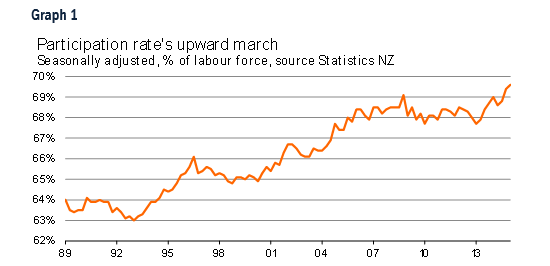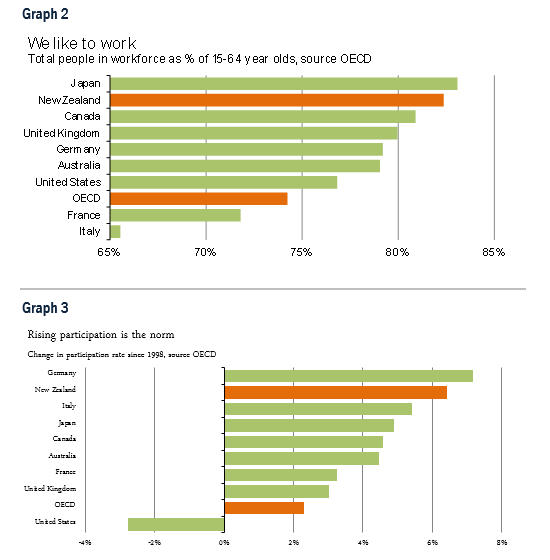
By Gareth Kiernan*

Labour market data released last week spooked financial markets a bit, with a static unemployment rate and no wage inflation increasing speculation about interest rate cuts by the Reserve Bank.
The most obvious reaction came from the dollar which dropped, on a TWI basis, more than 1% within a day to its lowest level in almost two months.
Financial markets had a heightened sensitivity to bad news given the easing bias adopted by the Reserve Bank in its most recent official cash rate review at the end of April.
So how did the labour market numbers compare to expectations?
• Employment growth was bang on market expectations (0.7% quarterly growth, 3.2% annual growth), although slightly stronger than the Reserve Bank’s pick of 3.0% pa growth.
• At 5.8%, the unemployment rate was worse than anyone expected, and higher than the Reserve Bank’s forecast of 5.5%.
• The participation rate of 69.6% was higher than market expectations.
The last figure helps explain how employment managed to be in line with expectations yet the unemployment rate still came in higher than forecast. Robust employment growth continues to draw more workers into the labour force. When taken in tandem with strong growth in the working-age population, the record high levels of participation have largely kept capacity and labour cost pressures at bay to date. Thus labour cost inflation, as measured by the labour cost index, was also weaker than the market expected.
There are two key questions for the Reserve Bank to grapple with when considering its monetary policy setting. Firstly, how sustainable is the lift in participation that has occurred? And secondly, given that wage growth is a lagging indicator of the economic cycle, are greater labour cost pressures just around the corner?

In response to the first question, Graph 1 shows a number of periods where there has been a significant upward trend in New Zealand’s participation rate.
During the 1990s, the increase in the retirement age from 60 to 65 increased labour force participation among 60-64 year olds from 24% in 1992 to 45% by 1999.
Between 2003 and early 2009, there was another lift in the participation rate, which has often been attributed to the incentives for second-income earners created by Working for Families.
However, the biggest contributions to the rising participation rate came predominantly from older people – the participation rate for 55-69 year olds rose from 55% to 63% during this period.
It’s a bit of a stretch to call the lift in the participation rate over the last couple of years a significant upward trend, with it rising from 66.9% to 68.0% (annual average) since June 2013. During that period, though, more 55-64 year olds continue to work, most of the biggest contributions to increased participation have come from 15-34 year olds.
Graph 2 shows that New Zealand’s record high participation rate is also among the highest in the OCED. The contrast with America’s participation rate, at its lowest level since 1978, is often highlighted, but looking at labour market trends across the OECD, the US is an outlier in this regard – as highlighted by Graph 3.

In other words, the high New Zealand participation rate doesn’t look unusual by international standards. It could also conceivably hold up around current levels over the medium term, although the increasing proportion of people aged over 65 presents some risk of a decline in coming years. For now, though, the Reserve Bank should probably interpret last week’s data as another factor challenging its view that the economy has very little spare capacity left to grow without generating inflation.
And that conclusion leads into the answer for our second question. If the economy has more spare capacity than previously thought, then it suggests that labour cost pressures are unlikely to rapidly escalate in the near term. This outcome is reinforced by the fact that, even with labour cost growth of 1.7%pa, real wages are still rising at their fastest rate in 16 years.
Last week’s data on its own is not enough to prompt the Reserve Bank to cut the OCR. But couple it with the negative effects of the latest GlobalDairyTrade auction results, which saw dairy prices drop past their December 2014 trough to a new six-year low, and the risk of an agricultural-led slowdown in the domestic economy is mounting. Dairy farmers might have been counting on a one-year dip in dairy prices, and if prices at least partially recovered in the coming season, then taking on a bit more debt to smooth over the temporary hole in incomes would seem sensible. But with farmgate prices set to remain well below $6/kgms in 2015/16 and possibly 2016/17 as well, farmers are likely to take an even more cautious approach to spending and add further weight to a slowdown in provincial New Zealand.
Earlier this year, low oil prices also looked like they would have a significant stimulatory effect on the economy, but that hope has proven to be relatively transitory. Petrol prices have now rebounded 21% since their January low and, at current levels, will add 0.5 percentage points back onto the CPI in the June quarter. Most critically, the rise in petrol prices will remove a sizable chunk of discretionary spending from households’ wallets, further cramping domestic demand and the potential for economic growth.
At this stage, we’re sticking to our forecast that the Bank will not cut the OCR this year, with the unemployment rate set to fall towards 5% in coming quarters and economic growth to remain sufficiently robust to forestall the need for any rate cut.
But it may not take much more of a deterioration in inflation expectations or other partial indicators to tip the Reserve Bank over the line into rate cut territory.
----------------------------------------------------
Gareth Kiernan is the chief forecaster and operations director at Infometrics, an economic consultancy and forecasting service. You can contact him here »

We welcome your comments below. If you are not already registered, please register to comment
Remember we welcome robust, respectful and insightful debate. We don't welcome abusive or defamatory comments and will de-register those repeatedly making such comments. Our current comment policy is here.